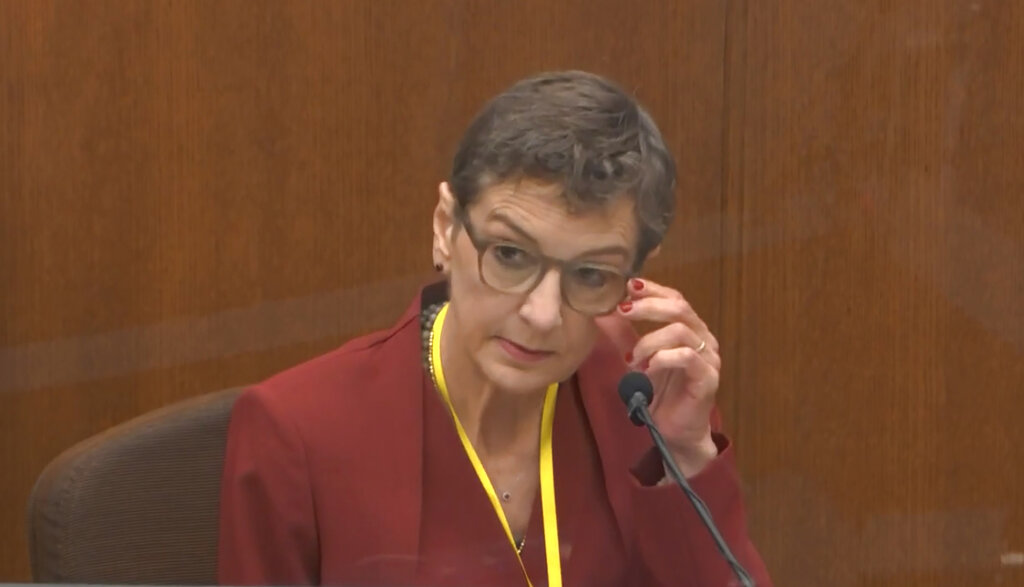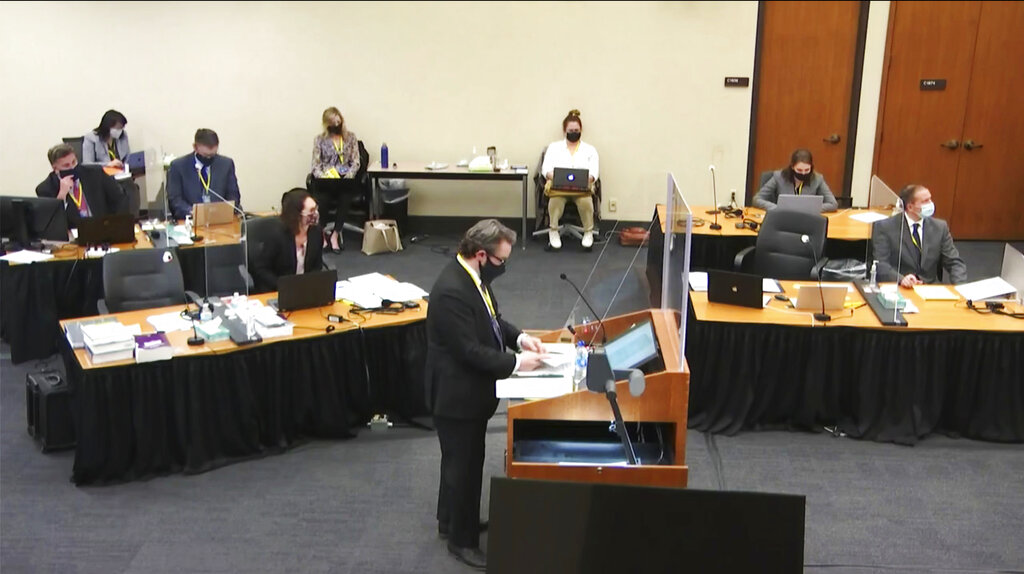Chauvin trial: Forensic pathologist says lack of oxygen, not drugs caused Floyd’s death

A protesters waves a Black Lives Matter flag across the street from the Hennepin County Government Center, Wednesday, April 7, 2021, in Minneapolis where testimony continues in the trial of former Minneapolis police officer Derek Chauvin continues. Chauvin is charged with murder in the death of George Floyd during an arrest last May in Minneapolis. (AP Photo/Jim Mone)
MINNEAPOLIS (NewsNation Now) — Testimony continues Friday in the murder trial of former Minneapolis police officer Derek Chauvin, charged in the death of George Floyd, a day after three medical experts took the stand saying Floyd was killed by police pinning him to the ground, not a drug overdose.
NewsNation will provide live coverage of the trial online and the NewsNation Now app. You can watch the trial here. The court has recessed for lunch Friday and will resume at 1:30 p.m. CST.
Chauvin, who is white, pressed his knee into the neck of Floyd, a 46-year-old Black man in handcuffs, for about nine minutes on May 25, 2020, a scene that ignited sometimes violent protests against police brutality across the nation.
The county medical examiner has ruled Floyd’s death a homicide at the hands of the police, while Chauvin’s lawyers have argued Floyd’s death was from a drug overdose. The Hennepin County Medical Examiner Andrew Baker who performed the autopsy on Floyd is expected to testify Friday following the highly technical and medical testimony the day prior.
Chauvin’s lawyer, Eric Nelson, has argued that Chauvin “did exactly what he had been trained to do over his 19-year career” and that it was Floyd’s use of illegal drugs and his underlying health conditions — not the officer’s knee — that killed him.
Before the jury heard testimony Friday, Judge Peter Cahill called in a juror and questioned her about whether she had been subject to any outside influences. She replied that she briefly saw TV coverage with the sound off and said that her mother-in-law had texted her, “Looks like it was a bad day” but that she didn’t reply.
Also of note, for the first time, a seat designated for Chauvin’s family was occupied Friday, by a woman. She wasn’t immediately identified. Chauvin’s marriage ended in divorce in the months after Floyd’s death.
Seats have been reserved for family members of both the Chauvin and Floyd families. A member of Floyd’s family often occupies a reserved seat in the back corner of the courtroom. Floyd’s younger brother Philonise Floyd, of Houston, has attended several days on behalf of his family.
Dr. Lindsey Thomas, forensic pathologist
The first witness called to the stand by the prosecution Friday was forensic pathologist Dr. Lindsey Thomas, who bolstered the findings of other medical experts’ testimony that it was a lack of oxygen from the way he was pinned to the street by police that caused his death.
Thomas retired from the Hennepin County Medical Examiner’s office in Minneapolis in 2017. Forensic pathologists investigate medical legal deaths, specifically the cause and manner of death, and are often called “the doctor’s doctor” as they provide information to doctors treating patients, said Thomas.
Thomas reviewed video of Floyd’s arrest and autopsy reports to make a determination on the terminal events, describing the volume of materials as “unique” because they were extensive, “so well-documented” and “thorough.”
The autopsy from Hennepin County stated “cardiopulmonary arrest complicating law enforcement subdual, restraint, and neck compression” as cause of death.

Thomas did not work on Floyd’s case but agreed with her former colleague Baker’s conclusion that Floyd died from cardiopulmonary arrest complicated by the way law enforcement restrained him and compressed his neck.
Thomas went further adding that “the primary mechanism of death was asphyxia or low level of oxygen” saying Floyd “was unable to get enough oxygen to maintain body functions.”
“This is a death where both the heart and lungs stopped working. The point is, it’s due to law enforcement subdual, restraint and compression,” Thomas said. “The activities of the law enforcement officers resulted in Mr. Floyd’s death.”
“This was not a sudden death… There was nothing sudden about his death,” said Thomas explaining why she did not believe cause of death was cardiac arrest from heart disease.
The autopsy itself ruled out heart attack, aneurysm, COVID-19 and other factors, and Thomas agreed.
“There is no evidence to suggest he would have died that night except for the interactions with law enforcement,” she said.
When asked by a prosecutor whether she ruled out drug overdose as a cause of death, Thomas replied “Yes.”
Under cross-examination by Nelson, Thomas said she believed Floyd’s heart was “slightly” enlarged.
Nelson asked Thomas about what could cause a heart to suddenly stop beating, noting that Floyd’s bigger heart needed more blood and was working hard in a moment of stress and adrenaline, and that one of his arteries had a 90% blockage.
Thomas said any blockage over 70% to 75% could be used to explain death, in the absence of another cause. But she also said some people can live just fine with an artery that is fully blocked.
The defense attorney pressed Thomas by posing a hypothetical question.
“Let’s assume you found Mr. Floyd dead in his residence. No police involvement, no drugs. … The only thing you found would be these facts about his heart. What would you conclude to be the cause of death?” Nelson asked.
“In that very narrow set of circumstances, I would probably conclude that the cause of death was his heart disease,” Thomas replied.
Floyd’s death certificate listed certain contributing conditions: narrowed arteries, high blood pressure, fentanyl intoxication and recent methamphetamine use. But Thomas said that they did not directly cause his death and that such factors are commonly included on death certificates to inform public health officials.
Testimony from medical experts on Thursday
Thursday’s testimony came from a toxicologist, a pulmonologist, and a forensic physician with the use of video evidence and courtroom technology to explain complex medical concepts to show that it wasn’t underlying health conditions or drug use that caused Floyd’s death but a lack of oxygen that was the cause of death.
An expert in the respiratory system, Dr. Martin Tobin, said Floyd’s breathing became fatally shallow under the police restraint but that the number of breaths he took per minute did not decrease up until the moment he lost consciousness, contradicting a defense theory.
Tobin said that a fentanyl overdose, in contrast, is marked by a sharp decrease in the frequency of breaths.

The shallow breaths resulted from a combination of measures applied by police, including placing Floyd prone on the street, handcuffing his hands behind his back and the officer kneeling on his back and neck, he said.
Tobin said videos showed Floyd trying to push his chest up from the street as he struggled for breath beneath Chauvin and two other officers.
“They’re pushing the handcuffs into his back and pushing them high, then on the other side you have the street,” Tobin said. “It’s like the left side is in a vise.”
Tobin said Floyd’s leg could be seen jumping up in an involuntary seizure as his brain was starved of oxygen.
Soon after, Tobin said, the moment came when Floyd did not have even “an ounce of oxygen left in his entire body,” although Chauvin’s knee stayed on Floyd’s neck for three more minutes.
In cross-examination, Eric Nelson, Chauvin’s lead lawyer, asked Tobin if he had personally weighed Chauvin, who in police reports is recorded as 140 pounds, or Chauvin’s equipment in order to calculate the pressure applied by the officer’s knee. Tobin said he had not.
Dr. Daniel Isenschmid, a doctor who tested Floyd blood samples, said the amount of methamphetamine in samples of blood taken after Floyd’s death, 19 nanograms per milliliter, was similar to levels a doctor would expect to see in a patient after taking a single dose of the drug in a prescribed form for attention-deficit disorder.

He said the concentration of fentanyl in Floyd’s blood was 11 ng/ml, and there was evidence a lot of the opioid had been broken down in Floyd’s body to norfentanyl, which a doctor would not expect to see in someone killed rapidly in an overdose.
Isenschmid also compiled data from his office on samples taken from people stopped for driving under the influence in 2020, noting people addicted to opioids need to take higher doses as tolerance builds up. The average level of fentanyl found in the blood of those people was 9.69 ng/ml, he said.
Dr. William Smock, emergency and forensic medicine expert, was the last witness to take the stand on Thursday.
“He died because he had no oxygen left in his body,” Smock testified, saying Floyd suffered from air hunger.
“He is saying: ‘Please, please. Get off of me, I want to breathe, I can’t breathe.’ That is not the fentanyl overdose, that is somebody begging to breathe,” he said.
On cross-examination, Nelson centered his questioning on Floyd’s methamphetamine and fentanyl use, his heart disease and having had the COVID-19 virus and his physical exertion during the struggle with police officers.
There was no evidence that Floyd had a heart attack or a drug overdose, Smock testified.
The Associated Press and Reuters contributed to this report. Reporting by Jonathan Allen and Brendan O’Brien of Reuters. Reporting by Amy Forliti, Steve Karnowski and Tammy Webber of Reuters.










